Zoom
Trash
Related: ivanchen
- Antibody-drug Conjugate
- BsAbs from Creative Biolabs
- Health
- Recombinant Antibodies
- CAR-T
- Education
- Enterprise

Receptor Activity-modifying Protein Family. "Creative Biolabs is committed to providing highly customized comprehensive solutions with the best quality to advance our global clients’ projects.

" Receptor Activity-modifying Protein Family Receptor activity-modifying proteins (RAMP) are a group of membrane-spanning accessory proteins that interact with and modulate the functions of several Class B G protein-coupled receptors (GPCRs) such as the receptors for secretin, glucagon, calcitonin (CT), and vasoactive intestinal peptide (VIP). Presenilin Family. "Creative Biolabs is committed to providing highly customized comprehensive solutions with the best quality to advance our global clients’ projects.
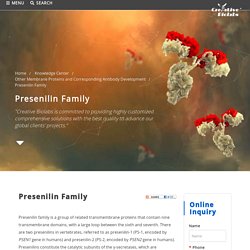
" Presenilin Family Presenilin family is a group of related transmembrane proteins that contain nine transmembrane domains, with a large loop between the sixth and seventh. There are two presenilins in vertebrates, referred to as presenilin-1 (PS-1, encoded by PSEN1 gene in humans) and presenilin-2 (PS-2, encoded by PSEN2 gene in humans). Junctophilin Family. "Creative Biolabs is committed to providing highly customized comprehensive solutions with the best quality to advance our global clients’ projects.
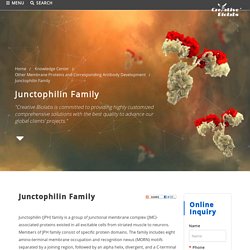
" Junctophilin Family Junctophilin (JPH) family is a group of junctional membrane complex (JMC)-associated proteins existed in all excitable cells from striated muscle to neurons. Members of JPH family consist of specific protein domains. The family includes eight amino-terminal membrane occupation and recognition nexus (MORN) motifs separated by a joining region, followed by an alpha helix, divergent, and a C-terminal transmembrane motif that anchors the protein into the endoplasmic reticulum (ER) or sarcoplasmic reticulum (SR). JHPs are involved in the formation of JMCs which connect the plasma membrane with the endoplasmic or sarcoplasmic reticulum in excitable cells.
The link between these proteins and its critical roles in all excitable cells indicate the implications of junctophilins for human physiology and pathophysiology. Cyclic Nucleotide-gated Cation Channel Family. "Creative Biolabs is committed to providing highly customized comprehensive solutions with the best quality to advance our global clients’ projects.
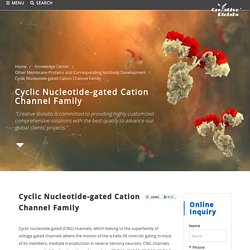
" Cyclic Nucleotide-gated Cation Channel Family Cyclic nucleotide-gated (CNG) channels, which belong to the superfamily of voltage-gated channels where the motion of the α-helix S6 controls gating in most of its members, mediate transduction in several sensory neurons. CNG channels are composed of 4 subunits, either of type alpha (CNGA1, CNGA2, CNGA3, CNGA4) or of type beta (CNGB1 and CNGB3) in mammals. These CNG channels use the free energy of cyclic nucleotides’ (CNs’) binding to open the pore, a process known as gating. Gating of CNG channels is initiated by the binding of CNs to the cyclic nucleotide-binding (CNB) domain and terminated with the opening of the gate located in the pore region, approximately some tens of Å apart.
Syntaxins Family. "Creative Biolabs is committed to providing highly customized comprehensive solutions with the best quality to advance our global clients’ projects.

" Syntaxins Family Syntaxins are the prototype family of SNARE [soluble NSF (N-ethylmaleimide-sensitive fusion protein)-attachment protein receptor] proteins involved in the membrane fusion process of synaptic vesicles with the presynaptic plasma membrane. In the exocytic and the endocytic pathway, syntaxins can mediate vesicle fusion in diverse vesicular transport processes through binding to other SNAREs and with the cytoplasmic NSF and SNAP. Besides, syntaxins can bind synaptotagmin in a calcium-dependent fashion and interact with voltage-dependent calcium and potassium channels involved in the depolarization of the presynaptic axonal boutons. Syntaxins have a similar structure that contains a single C-terminal pass-membrane domain, a SNARE domain, and an N-terminal domain. There are 15 members of the syntaxin family in the human genome. Small Conductance Calcium-activated Potassium Channel Protein Family.
"Creative Biolabs is committed to providing highly customized comprehensive solutions with the best quality to advance our global clients’ projects.
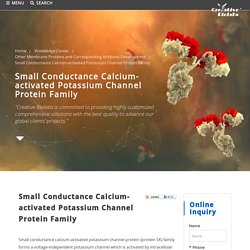
" Small Conductance Calcium-activated Potassium Channel Protein Family Small conductance calcium-activated potassium channel protein (protein SK) family forms a voltage-independent potassium channel which is activated by intracellular calcium. And the activation is followed by membrane hyperpolarization. Protein SK is suggested to modulate neuronal excitability by contributing to the slow component of synaptic afterhyperpolarization. IP3 Receptor Family. "Creative Biolabs is committed to providing highly customized comprehensive solutions with the best quality to advance our global clients’ projects.
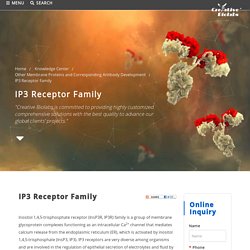
" IP3 Receptor Family Inositol 1,4,5-trisphosphate receptor (InsP3R, IP3R) family is a group of membrane glycoprotein complexes functioning as an intracellular Ca2+ channel that mediates calcium release from the endoplasmic reticulum (ER), which is activated by inositol 1,4,5-trisphosphate (InsP3, IP3). IP3 receptors are very diverse among organisms and are involved in the regulation of epithelial secretion of electrolytes and fluid by the interaction with AHCYL1. They represent dominant second messengers inducing the release of Ca2+ from intracellular store sites. IP3 receptors are suggested to play a role in ER stress-induced cell apoptosis. Voltage-gated Potassium Channel Beta Subunit Family. "Creative Biolabs is committed to providing highly customized comprehensive solutions with the best quality to advance our global clients’ projects.
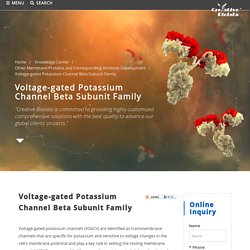
" Voltage-gated Potassium Channel Beta Subunit Family Voltage-gated potassium channels (VGKCs) are identified as transmembrane channels that are specific for potassium and sensitive to voltage changes in the cell's membrane potential and play a key role in setting the resting membrane potential. VGKCs are assembled from membrane-integrated alpha subunits and auxiliary beta subunits and are involved in a variety of functions, including secretion, electrogenesis, and cell motility. Voltage-gated potassium channel beta subunits are cytoplasmic proteins that co-purify with the pore-forming alpha subunits. Protein Unc Homolog Family. "Creative Biolabs is committed to providing highly customized comprehensive solutions with the best quality to advance our global clients’ projects.
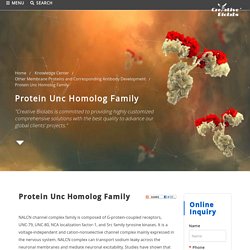
" Protein Unc Homolog Family NALCN channel complex family is composed of G-protein-coupled receptors, UNC-79, UNC-80, NCA localization factor-1, and Src family tyrosine kinases. It is a voltage-independent and cation-nonselective channel complex mainly expressed in the nervous system. NALCN complex can transport sodium leaky across the neuronal membranes and mediate neuronal excitability.
Studies have shown that NALCN complex is involved in many biological processes including locomotor behaviors, rhythms behaviors, and sensitivity to volatile anesthetics. Atypical Chemokine Receptor Family. "Creative Biolabs is committed to providing highly customized comprehensive solutions with the best quality to advance our global clients’ projects.
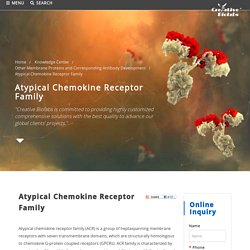
" Atypical Chemokine Receptor Family Atypical chemokine receptor family (ACR) is a group of heptaspanning membrane receptors with seven transmembrane domains, which are structurally homologous to chemokine G-protein coupled receptors (GPCRs). Modeling of Antibody Framework Regions. Creative Biolabs is an undisputed global leader in the rapidly emerging market of antibody structure modeling.
With our professional scientists hammering at Creative Biolabs, we offer accurate antibody 3D-structure models with our high-quality framework regions modeling service. We are confident to deliver you the best modeling service to meet your individual requirements. Framework Region of Antibody Antibodies are composed of four polypeptides– two heavy chains and two light chains joined to form a "Y" shaped molecule.
Modeling of Antibody Framework Regions. Loop Structure of Antibody Refinement. Creative Biolabs possesses unchallenged experience in antibody structure modelling. With our well-developed antibody structure modelling platform, multiple modelling strategies are available here. We offer high-quality loop structure refinement service to assist you to generate an expected antibody structure. Loop Structure of Antibody. Homology Antibody Modeling. Homology antibody modeling is one of the most commonly used antibody modeling methods. Taking advantage of our unchallenged experience in antibody modeling, Creative Biolabs is committed to providing customer expected antibody homology models with high accuracy for your research purpose.
Computational structure prediction of antibodies is an essential step in the modeling and creating new antibodies with desired therapeutic properties. As the variable domains (Fvs) of the heavy and light chain responsible to most or all of the specificity of an antibody for its antigen target, they are of special interest. The Fv contains two regions: the hypervariable regions also called complementarity-determining regions (CDRs), and the framework regions (FRs). Epitope-specific Antibody Design. As a leading custom service provider in antibody field, Creative Biolabs now offers a range of epitope-specific antibody design services. With our well established epitope-specific antibody design platform, we are confident in providing unique epitope-specific antibodies with high specificity and affinity. Due to the ability to bind certain molecules with high affinity and specificity, antibodies become potent tools in life sciences research, as well as in diagnostic and therapeutic applications.
Antibody Developability Prediction. Developability refers to the possibility for the successful development of a lead candidate into a stable, safe, manufacturable, and efficacious drug, which is enable to be used as an additional selection criterion. By using a class of small-scale, fast, and predictive tests addressing biochemical and biophysical features, as well as in silico analysis, enable to evaluate a clinical candidate molecule with promising properties at an early stage of drug development. With years of exploration in antibody engineering, Creative Biolabs has built a full-scale in silico technology platform. Computer-Aided Antibody Design. Antibody Structure Determination. Antibody Structure Modeling. CD96 - Creative Biolabs. Results found for "gfap" - Creative Biolabs. BRAF - Creative Biolabs. CTNNB1 - Creative Biolabs. CTLA-4 - Creative Biolabs. TP53 - Creative Biolabs. Results found for "androgen receptor" - Creative Biolabs. Results found for "aif1" - Creative Biolabs.
Results found for "actin" - Creative Biolabs. Results found for "actin" - Creative Biolabs. Antibody - Creative Biolabs. CD96 - Creative Biolabs. Results found for "gfap" - Creative Biolabs. BRAF - Creative Biolabs. Inflammatory Diseases. IVD Antibody Development Platform. IVD Antibodies for Cancer. Cancer is a class of diseases characterized by out-of-control cell growth with the potential to invade or spread to other parts of the body. The unregulated growth of cells leads to the formation of tumors, which can be benign or malignant.
Tumors that stay in one spot and demonstrate limited growth are generally considered to be benign, while cells that can pass more easily through smaller gaps, invade nearby tissues, and spread to other parts of the body, are malignant. Cancer is a genetic disease which is caused by changes to genes that control the way our cells function, especially how they grow and divide. The genes involved include oncogenes, tumor suppressor genes, suicide genes, and DNA-repair genes.
Environmental risk factors that contribute to cancers include tobacco use, obesity, poor diet, lack of physical activity, excessive alcohol, infections, etc. In Vitro Diagnostic Antibodies. In Vitro Diagnostic (IVD) Antibodies In Vitro Diagnostics (IVD) are tests used to detect and in diagnosis of disease, infections or other medical conditions, including a determination of the state of health, in order to cure, mitigate, treat, or prevent disease or its sequelae.
They’re intended for use in the collection, preparation, and examination of specimens taken from the human body. Common uses for in vitro diagnostics including but not limited to disease screening, infections detecting, therapeutic monitoring, ensuring blood is safe to be used in transfusions, and recognizing of allergies and the measurement of hormones and other biological markers in body specimen. Antibodies have become a critical component of many diagnostic assays. Creative Biolabs develops and licenses antibodies for use in In Vitro Diagnostic (IVD) assays as a qualified IVD supplier. A comprehensive platform for IVD antibody development, protein conjugation, and IVD kit development. Autoimmune Diseases. Autoimmunity involves the loss of normal immune homeostasis such that the organism produces an abnormal response to its own self tissue.
Our bodies have an immune system, which is a complex network of special cells and organs that defends the body from germs and other foreign invaders. At the core of the immune system is the ability to tell the difference between self and non-self. A flaw can make the body unable to tell the difference between self and non-self. When this happens, the body makes autoantibodies that attack normal cells by mistake. At the same time, special cells called regulatory T cells fail to do their job of keeping the immune system in line. Diagnosis of Autoimmune Diseases When evaluating a patient with suspected autoimmune disease, a combination of laboratory tests and a review of symptoms and physical examinations are often used.
Diagnostic Biomarkers of Autoimmune Diseases Autoantibodies are the most commonly used diagnostic biomarkers of autoimmune diseases. IVD Antibody Development Services for Myeloperoxidase Marker. IVD Antibodies for Cancer.